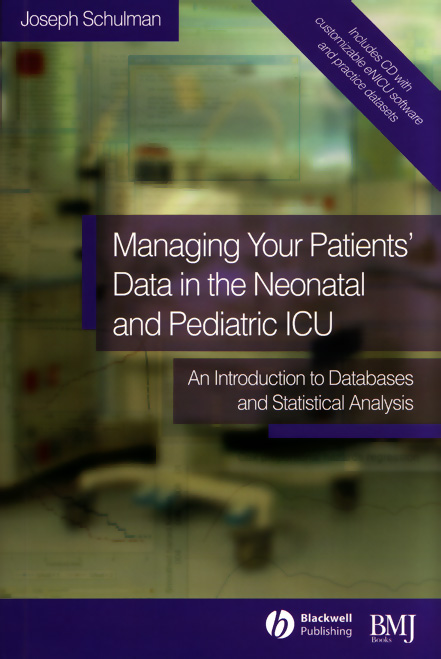Managing Your Patients’ Data in the Neonatal and Pediatric ICU
by Joseph Schulman

This
new text offers a nice marriage of database management and statistical
analysis in Stata. Although the database management software and
related discussion are specific to the author’s institution, readers in
similar clinical environments should easily be able to adapt the
content to their local situations. Indeed, readers looking for a
practical application of Stata’s odbc command for interacting with
databases will find this text quite useful.
The standard methods of the biostatistician’s toolbox are all covered,
from epidemiological tables to survival analysis to logistic
regression, the analyses therein performed entirely using Stata.
Table of contents
eNICU installation and administration instructions
Acknowledgments
Chapter 1: Introduction
Part 1: Managing data and routine reporting
Section 1: The process of managing clinical data
- Chapter 2: Paper-based patient records
Chapter 3: Computer-based patient records
Chapter 4: Aims of a patient data management process
Section 2: Modeling data: Accurately representing our work and storing the data so we may reliably retrieve them
Chapter 5: Data, information, and knowledge
Chapter 6: Single tables and their limitations
Chapter 7:
Multiple tables: where to put the data, relationships among tables,
and
creating a database
Chapter 8:
Relational database management systems: normalization (Codd’s rules)
Section 3: Database software
- Chapter 9: From data model to database software
Chapter 10: Integrity: anticipating and preventing data accuracy problems
Chapter 11: Queries, forms, and reports
Chapter 12: Programming for greater software control
Chapter 13: Turning ideas into a useful tool: eNICU, point of care database software
- for the NICU
Chapter 14: Making eNICU serve your own needs
Section 4: Database administration
- Chapter 15: Single versus multiple users
Chapter 16: Backup and recovery: assuring your data persists
Chapter 17: Security: controlling access and protecting patient confidentiality
Conclusion Part I: Maintaining focus on a moving target
Part 2: Learning from aggregate experience: exploring and analyzing data sets
Section 5: Interrogating data
Chapter 18:
Asking questions of a data set: crafting a conceptual framework and
testable hypothesis
Chapter 19:
Stata: a software tool to analyze data and produce graphical displays
Chapter 20: Preparing to analyze data
Section 6: Analytical concepts and methods
- Chapter 21: Variable types
Chapter 22: Measurement values vary: describing their distribution and summarizing
- them quantitatively
Chapter 23: Data from all versus some: populations and samples
Chapter 24: Estimating population parameters: confidence intervals
Chapter 25: Comparing two sample means and testing a hypothesis
Chapter 26: Type I and type II error in a hypothesis test, power, and sample size
Chapter 27: Comparing proportions: introduction to rates and odds
Chapter 28: Stratifying the analysis of dichotomous outcomes: confounders and
-
effect modifiers; the Mantel–Haenszel method
Chapter 29: Ways to measure and compare the frequency of outcomes
Chapter 30: Comparing the means of more than two samples
Chapter 31: Assuming little about the data: nonparametric methods of hypothesis
- testing
Chapter 32: Correlation: measuring the relationship between two continuous
- variables
Chapter 33: Predicting continuous outcomes: univariate and multivariate linear
- regression
Chapter 34: Predicting dichotomous outcomes: logistic regression, and receiver
- operating characteristics
Chapter 35: Predicting outcomes over time: survival analysis
Chapter 36: Choosing variables and hypotheses: practical considerations
Conclusion: The challenge of transforming data and information to shared knowledge: tools that make us smart
References
Index
CD_ROM: eNICU files; practice data sets


|



